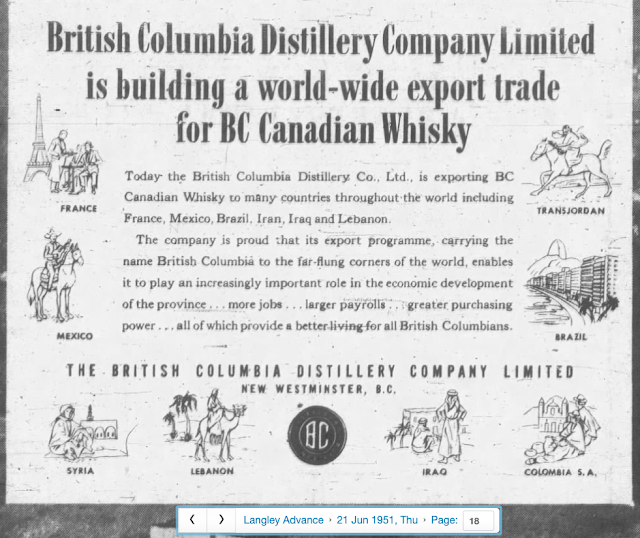** all newspaper clippings are from newspapers.com. If you are doing serious historical research, I recommend paying for a subscription. It is absolutely invaluable.
The British Columbia Distillery Company of New Westminster, BC, was founded in 1903 before June 9 as the Vancouver Semi-Weekly World announced that day (p.5):
It was touted as British Columbia's first distillery (Chilliwack Progress December 17, 1952 p.10), undoubtedly, there had been stills in the province for decades, but this was the first official one.
By 1910 BCDC was well established in Sappertown, and supplied products throughout BC, the Yukon, Western Canada, and the U.S., as well as "... the remotest ends of the earth and especially into every part of civilization where rye whiskey is appreciated." (B. C. Saturday Sunset, New Westminster, July 10, 1910:54).
During World War I, the British Columbia Distillery apparently sent whisky to Scotland and France (or at least they were looking into it):

On October 1, 1917, British Columbia went mostly dry. Every bar, brewery, and distillery were prohibited from selling liquor within the province. Consumers could still import alcohol and the makers could export if they had a market, and there were exemptions for medical, dental, religious and other uses, but essentially the province went dry. “Except as provided by this Act, no person shall, within the province … expose for sale … sell or barter, or offer to sell or barter … or at the time of the transfer of any property or thing give to any other person any liquor” (Vancouver Daily World, September 29, 1917). After a federal order-in-council effective April 1, 1918, importation was not allowed until a year after the war was over (ended up being January 1, 1920). In theory, therefore, BC was completely dry from April 1, 1918 to January 1, 1920 (https://core.ac.uk/download/pdf/56370353.pdf).
And, indeed, a newspaper article from a South Carolina in 1919 explains that the B.C. Distillery Company sent Mr. M. McCideel to the Orient to scout for business in the Far East:
I don't know how successful they were with this business in the Far East or if the Scotland/France thing worked out, but they survived the war and Prohibition and were one of the first Distilleries to get a government license in 1921 after the Liquor Control Board was formed that year (
https://open.library.ubc.ca/collections/bcsessional/items/1.0225847?o=0).
Bottle shapes and sizes changed over the years. The ads below show the variation between the 1920s and the 1940s. Also, this Vancouver Museum bottle shows what is possibly a bottle from the 1920s as it shares a label with the 1924 ad (also see the "24" cut into the label upper left) and was made in an Owens machine which was patented in 1904 (
https://5111.sydneyplus.com/argus/final/portal.aspx?lang=en-CA) (as of the October 10, 2022, the museum website has incorrect information about the bottle and the company - I have shared this post with them).
A 1923 ad shows them marketing Caledonia Whisky (malted barley) and Rye Whisky:
This ad is from 1924 showing their label on a Rye (or Canadian) Whisky bottle:
And a similar ad with same label from 1927:
Ads from 1936 and 1938 show the range of bottle shapes and sizes:
The British Columbia Distilling Company was bought out by Seagrams in 1941:
The BCDC bottles by the 1940s had changed from the old whisky style bottles of the 1920s to most of the products being in the 1930s-style flask-shaped bottle: The Grand Forks Gazette December 19, 1940:
The distillery was quite large by 1927 (sorry for the quality) (photo from the New Westminster Archives item 3368):
By 1967, you can see that two larger buildings (upper left) have been added as well as some changes in the upper right (this was a very poor quality aerial photo from https://www2.gov.bc.ca/gov/content/data/geographic-data-services/digital-imagery/air-photos. I improved it as much as I could):
By the 1950s, the BCDC was a truly international business:
I was gifted this bottle by a friend and colleague who lives in BC. I have no provenience for it, and no firm date. It was made by the Dominion Glass Co. as evidenced by the D in the diamond on the right hand side of the base. That mark was apparently first used in 1913, but the trademark on the base of the bottle indicates it is post-1921 (see below). I could not find trademark information for the BCDC in the crest or BCD in script in the circle - although they both should be in the trademark database, they are not. It does appear to have been made by a fully automatic machine but not an Owens (Owens dominated the market between the mid 1910s and through the early 1930s), and shares shape and style with the 1930s and 40s bottles.




The Bakelite cap reads "Hiram Walker & Sons Ltd". I don't think it is original to the bottle as I have found no evidence of the BCDC producing whisky for Hiram Walkers. But I could very well be wrong (the cap fits the bottle very well). Hiram Walker & Sons of Windsor, Ontario, registered this trademark on June 14, 1887 (http://www.ic.gc.ca/app/opic-cipo/trdmrks/srch/viewTrademark?id=0012148&tab=reg&lang=eng).












com%20BO_47_604%201947.jpeg)








Comments
Post a Comment